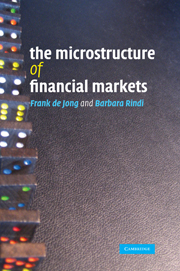Book contents
- Frontmatter
- Contents
- List of figures
- List of tables
- Preface
- Introduction
- 1 Institutions and market structure
- 2 Financial market equilibrium
- 3 Batch markets with strategic informed traders
- 4 Dealer markets: information-based models
- 5 Inventory models
- 6 Empirical models of market microstructure
- 7 Liquidity and asset pricing
- 8 Models of the limit order book
- 9 Price discovery
- 10 Policy issues in financial market structure
- Index
5 - Inventory models
Published online by Cambridge University Press: 05 June 2012
- Frontmatter
- Contents
- List of figures
- List of tables
- Preface
- Introduction
- 1 Institutions and market structure
- 2 Financial market equilibrium
- 3 Batch markets with strategic informed traders
- 4 Dealer markets: information-based models
- 5 Inventory models
- 6 Empirical models of market microstructure
- 7 Liquidity and asset pricing
- 8 Models of the limit order book
- 9 Price discovery
- 10 Policy issues in financial market structure
- Index
Summary
Chapter 4 discussed a model where dealers quote bid and ask prices that deviate from the fundamental value of the asset in order to offset the adverse selection costs that arise in the case of asymmetric information. We therefore assumed risk neutrality, so that dealers would be concerned only with adverse selection costs. In real markets, however, dealers also act as mandatory liquidity suppliers and are obliged to quote prices continuously. This means they will frequently hold undesired portfolio positions that do not lie on their efficient frontier. The costs that dealers must sustain for holding undesired positions – called ‘inventory costs’ – are another determinant of the bid–ask spread. In fact, through opposite changes in the bid–ask quotations, dealers can encourage transactions by their customers that will rebalance their portfolio. Clearly, in this context, it is crucial to assume that dealers are risk-averse, since only the risk-averse are concerned about the possible losses due to future adverse price changes.
Inventory models assign an important role to market-makers who offer the opportunity to trade at all times and therefore act as immediacy providers. The initial modelling approach (Garman, 1976) to the market-makers' control problem assumes that their objective is to avoid bankruptcy (the ‘ruin problem’), which could be caused by the uncertainty induced by the arrival of non-synchronous buy and sell orders. As O'Hara (1995) suggests, this approach is not realistic since it assumes that a dealer quotes his prices only at the beginning of the trading game, so his inventory plays no role in the decision.
- Type
- Chapter
- Information
- The Microstructure of Financial Markets , pp. 80 - 90Publisher: Cambridge University PressPrint publication year: 2009

